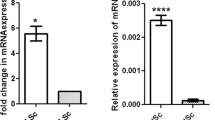Abstract
MÜLLERIAN inhibiting substance (MIS), also known as anti-Müllerian hormone, is a glycoprotein1–4 normally secreted by the Sertoli cells of the fetal and adult testis5,6 and by granulosa cells of the postnatal ovary7,8. The production of MIS in the male fetus brings about the regression of the Müllerian ducts, the anlagen of the uterus, oviducts, and upper vagina9–11. In addition, purified MIS induces the formation of seminiferous cord-like structures in fetal rat ovaries cultured in vitro, suggesting that MIS may influence testicular differentiation12. We have produced transgenic mice chronically expressing human MIS under the control of the mouse metallothionein-1 promoter to investigate its role during sexual development. In females, chronic expression led to the inhibition of Müllerian duct differentiation, resulting in a blind vagina and no uterus or oviducts. At birth the ovaries had fewer germ cells than normal; during the next two weeks germ cells were lost and the somatic cells became organized into structures resembling seminiferous tubules. Apparently, these structures degenerate as they are undetectable in adult females. The majority of transgenic males developed normally. But in two lines with the highest levels of MIS expression, some males showed feminization of the external genitalia, impairment of Wolffian duct development, and undescended testes. These results suggest that MIS has several distinct roles in mammalian sexual development.
This is a preview of subscription content, access via your institution
Access options
Subscribe to this journal
Receive 51 print issues and online access
$199.00 per year
only $3.90 per issue
Buy this article
- Purchase on Springer Link
- Instant access to full article PDF
Prices may be subject to local taxes which are calculated during checkout
Similar content being viewed by others
References
Picard, J. Y. & Josso, N. Molec. cell. Endocrinol. 34, 23–29 (1984).
Budzik, G. P., Powell, S. M., Kamagata, S. & Donahoe, P. K. Cell 34, 307–314 (1983).
Cate, R. L. et al. Cell 45, 685–698 (1986).
Picard, J. Y., Benarous, R., Guerrier, D., Josso, N. & Kahn, A. Proc. natn. Acad. Sci. U.S.A. 83, 5464–5468 (1986).
Donahoe, P. K., Ito, Y., Price, J. M. & Hendren, W. H. III Biol. Reprod. 16, 238–243 (1977).
Vigier, B., Tran, D., Du Mesnil du Buisson, F., Heyman, Y. & Josso, N. J. Reprod. Fertil. 69, 207–214 (1983).
Hutson, J., Ikawa, H. & Donahoe, P. K. J. Pedlat. Surg. 16, 822–827 (1981).
Vigier, B., Picard, J. Y., Tran, D., Legeai, L. & Josso, N. Endocrinology 114, 1315–1320 (1984).
Jost, A. Arch. Anat. Micro. Morph. Exp. 36, 271–315 (1947).
Josso, N. & Picard, J. Y. Physiol. Rev. 66, 1038–1090 (1986).
Hutson, J. M. et al. in Comprehensive Endocrinology Series: The Testis (eds Burger, H. & De Kretser, D.) 14, 143–180 (Raven, New York, 1989).
Vigier, B., Watrin, F., Magre, S., Tran, D. & Josso, N. Development 100, 43–55 (1987).
Brinster, R. L., Chen, H. Y., Trumbauer, M. E., Yagle, M. K. & Palmiter, R. D. Proc. natn. Acad. Sci. U.S.A. 82, 4438–4442 (1985).
Palmiter, R. D. et al. Science 222, 809–814 (1983).
Hudson, P. L. et al. J. clin. endocr. Metab. 70, 16–22 (1990).
Bishop, C. E. & Hatat, D. Nucleic Acids Res. 15, 2959–2969 (1987).
Imperato-McGinley, J. & Gautier, T. Trends Genet. 2, 130–133 (1986).
Lyon, M. F. & Hawkes, S. G. Nature 227, 1217–1219 (1970).
Kratochwll, K. in Manipulation of Mammalian Development 315–333 (Plenum, New York, 1986).
Hutson, J. M. & Donahoe, P. K. Endocr. Rev. 7, 270–283 (1986).
Fritz, I. B. in Intraovarian Control Mechanisms (eds Channing, C. P. & Segal, S. J.) 357–384 (Plenum, New York 1982).
Jost, A., Perchellet, J. P., Prepin, J. & Vigier, B. in Symposium on Intersexuality, 392–406 (Springer, New York, 1975).
Vigier, B. et al. Proc. natn. Acad. Sci. U.S.A. 86, 3684–3688 (1986).
Russell, E. S. & Fekete, E. J. natn. Cancer Inst. 21, 365–381 (1958).
Guerrier, D. et al. J. clin. endocr. Metab. 68, 46–52 (1989).
Burgoyne, P. S., Buehr, M., Koopman, P., Rossant, J. & McLaren, A. Development 102, 443–450 (1988).
Burgoyne, P. S. Buehr, M. & McLaren, A. Development 104, 683–688 (1988).
Author information
Authors and Affiliations
Rights and permissions
About this article
Cite this article
Behringer, R., Cate, R., Froelick, G. et al. Abnormal sexual development in transgenic mice chronically expressing Müllerian inhibiting substance. Nature 345, 167–170 (1990). https://doi.org/10.1038/345167a0
Received:
Accepted:
Issue Date:
DOI: https://doi.org/10.1038/345167a0
This article is cited by
-
A time-course transcriptome analysis of gonads from yellow catfish (Pelteobagrus fulvidraco) reveals genes associated with gonad development
BMC Genomics (2022)
-
Organoid systems to study the human female reproductive tract and pregnancy
Cell Death & Differentiation (2021)
-
Transcriptional landscape of the embryonic chicken Müllerian duct
BMC Genomics (2020)
-
Regulation of male sex determination: genital ridge formation and Sry activation in mice
Cellular and Molecular Life Sciences (2014)
-
Anti-Müllerian hormone may regulate the number of calbindin-positive neurons in the sexually dimorphic nucleus of the preoptic area of male mice
Biology of Sex Differences (2013)
Comments
By submitting a comment you agree to abide by our Terms and Community Guidelines. If you find something abusive or that does not comply with our terms or guidelines please flag it as inappropriate.



